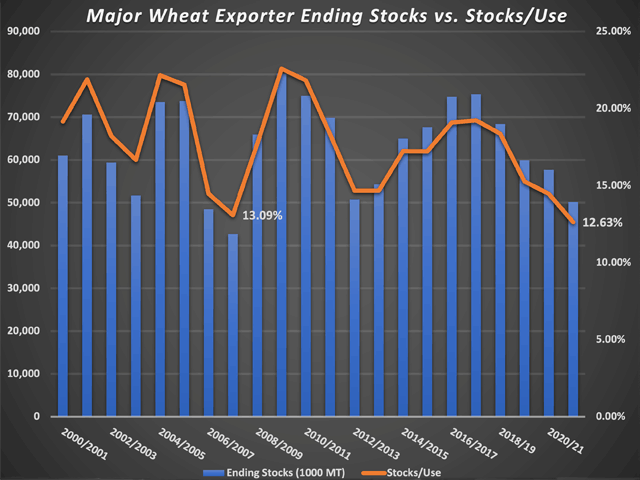The 5thWave Forum
Wheat's Supply and Demand Situation Growing Precarious for Globe's Exporters
The August World Agricultural Supply and Demand Estimates (WASDE) report is one of the higher-profile USDA reports of the year, as it offers the first objective yield estimates using farmer surveys and satellite imagery. The row-crop yields will continue to be refined in coming months with test plot data and actual harvest results. While USDA's estimates of the row-crop yields coming in well under the average trade guesses stole the show, equally important data for the global wheat balance sheet was also released.
For much of the last five years, the world has been awash with wheat, as ending stocks pushed toward 300 million metric tons (mmt). If one part of the world had a production shortfall, it seemed like enough others were waiting with available supply. That seems to have changed with the production issues in the U.S. Northern Plains, Canada and Russia. In addition, the massive supply of wheat in China is slowly starting to get whittled down with imports looking as though they could be a regular occurrence moving forward.
P[L1] D[0x0] M[300x250] OOP[F] ADUNIT[] T[]
On the July WASDE, USDA slashed the U.S. spring wheat crop well under trade expectations, officially putting global importers of high-protein wheat on notice. This month, USDA followed suit with Canadian wheat production being cut to 24.0 mmt, which would be the smallest crop since 2010-11. The average yield of 2.61 metric tons per hectare would be the smallest since 2007-08, assuming harvested acreage doesn't fall further as fields get abandoned.
To throw more fuel on the fire, USDA also cut Russian wheat production more than expected to 72.5 mmt, which is the smallest crop since 2018-19. These cuts were partially offset by increases in Ukraine and the European Union, but the EU doesn't produce the same kind of hard wheat that the U.S., Canada and Russia do. In 2020-21, Russia was the largest wheat exporter in the world with Canada ranking third and the United States fourth.
Combining all the major exporters together helps us get a sense of the supply of available wheat to the world. For this analysis, the major exporters will include Argentina, Australia, Canada, the EU, Kazakhstan, Russia, Ukraine and the United States. This group is projected to have combined production of 377.2 mmt in 2021-22, which is just above the five-year average of 376.9 mmt. Total supplies are seen at 446.3 mmt versus the five-year average of 457.1 mmt. Total usage, which includes domestic consumption and exports, is projected at 397.3 mmt, which is the second largest on record behind last year's 398.7 mmt. This allows ending stocks to drop to 50.1 mmt, the smallest since 2007-08. Even more important, the combined stocks-to-use ratio of 12.63% would be the smallest on record going back to at least 1980-81. The previous record-low stocks-to-use ratio occurred in 2007-08 at 13.09%.
Adding a further wrinkle to this situation is the unpredictability of China. As noted above, the burdensome supplies of wheat in China helped keep a lid on the global wheat balance sheet much of the last five years, even though most knew that wheat was not available to the larger marketplace. Ending supplies of wheat in China peaked in 2019-20 at 150.5 mmt, with projected 2021-22 ending stocks of 141.6 mmt.
As we've written about previously, however, the item to focus on in the Chinese wheat balance sheet is not ending stocks; instead, analysts should be focusing on the deficit or surplus between production and demand. In 2020-21, the difference between Chinese production and demand was a deficit of 16.5 mmt. That environment saw China increase wheat imports to 10.6 mmt, the largest in 25 years. For 2021-22, China is expected to have a deficit of 13.0 mmt, with imports currently projected by USDA at 10.0 mmt. China has both a quality wheat and a feed grain problem, regardless of what their supply numbers would suggest as evidenced by their domestic wheat price.
Wheat has been in the follower role of the ag space since last August, and for good reason. However, enough production issues have arisen this growing season to bring the world's exportable reserve down to the lowest outright supplies in over a decade and the lowest as a percentage of use on record. Considering the surging inflationary environment and the suspect supply chains being witnessed around the globe, the wheat market could be walking into a potentially explosive situation over the next six to 12 months. If you add in the fact that the world's largest producer and consumer of wheat could become a steady importer moving forward -- wheat price might not be content to remain in its follower role any longer.
Tregg Cronin can be reached at tmcronin31@gmail.com
Follow him on Twitter @5thWave_tcronin
(c) Copyright 2021 DTN, LLC. All rights reserved.




